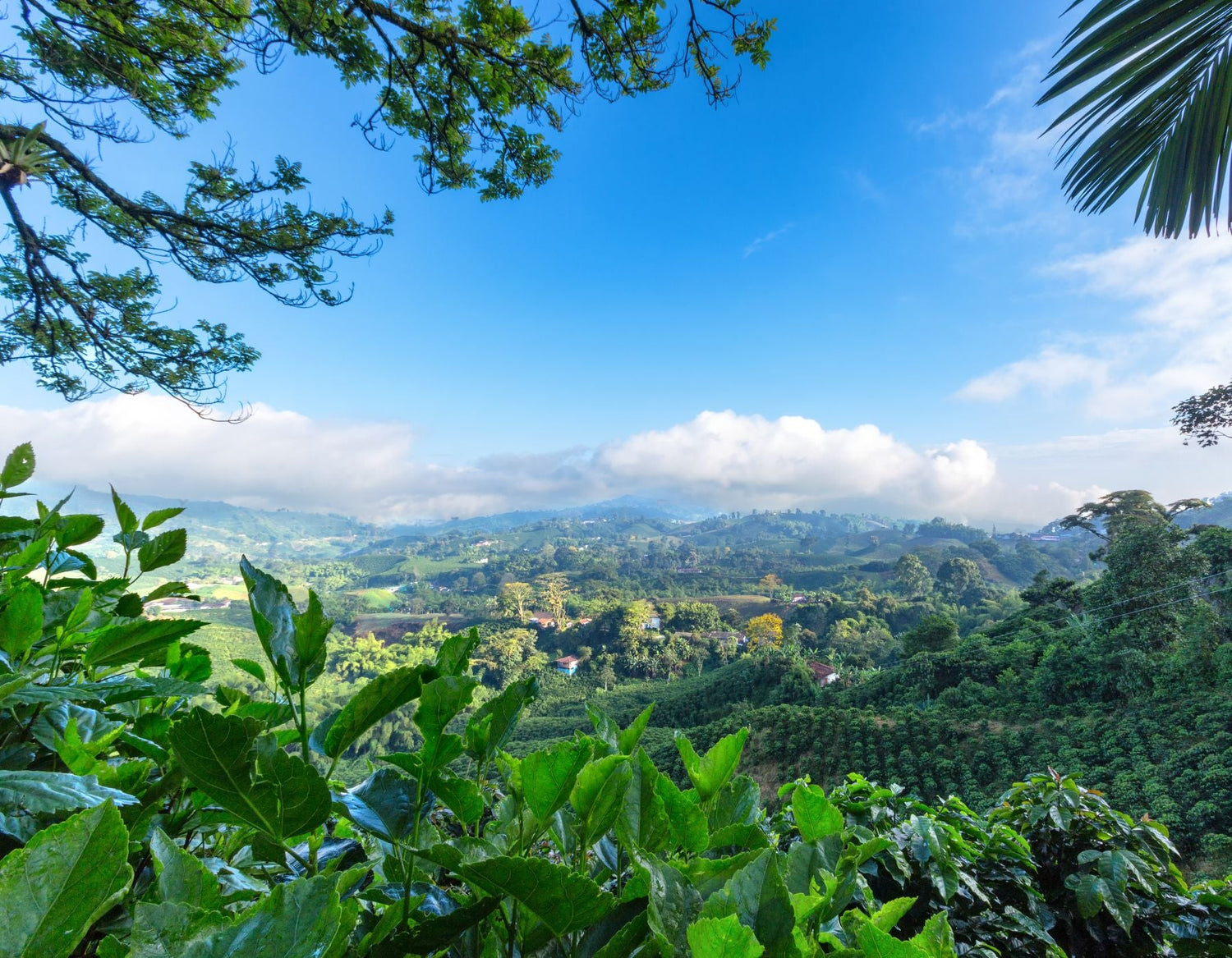By:GERARDO RAMOS
A TRIP TO A COFFEE TYPICAL FARM
The plethora of indispensable elements, which if we look beyond our noses, are innumerable,
the cycle of the coffee bean to the pleasing and desired beverage.
Traveling through the coffee region, and if we are fortunate enough to have the opportunity to be in the Colombian coffee region, we will find
Colombian coffee region, we find monuments to beauty in complete harmony with nature.
Generally, the first thing that attracts us is the perception of spaciousness that is noticeable from any distance.
distance. Some of them are square in shape, although most of them are a long strip. Balcony and/or corridors are
are indispensable and without them the beauty would be lame.
A multiplicity of colors attractive to the eye begin to give shape to the idea of a very
and even more so for those who live in it.
Curiosity leads us to be a little more inquisitive about this beauty that we observe from a distance.
distance and as we get closer the surprised features reflect the faces of children when they receive a longed for or favorite gift.
or favorite gift.
We begin to appreciate, now, in detail the vividness of the colors. They are fiery, stand out and do not
play against the peasant atmosphere. Harmony dances sweetly before our eyes.
After this pleasant visual welcome, we begin our tour of the coffee plantation house,
The plants hanging from the beams, which support the roof, located in strategic and symmetrical places for the view, serve as an extension of the
the view, serve as an extension of the coffee environment.
The bride and groom, the pansies, the geraniums, the deer antlers and a multiplicity of flowering plants complementary to the flowering
and a multiplicity of flowering plants complementary to the coffee bush serve as ornaments in these houses.
The affection that they receive is returned by offering to those who admire them a beautiful silhouette and an even more striking color in their flowers and their
and an even more striking color in their flowers and leaves. But this is not gratuitous, it would not have appeared there if it were not for the wonderful hand, the love and the
the marvelous hand, love and tenderness of one of the least recognized beings in the entire stage of coffee production.
the entire stage of coffee production, which is the woman. The multiplicity and variety contribute to
and pleasant moment.
After leaving the ecstasy that the initial sight produced in us, we went to walk through the spacious corridors.
corridors. One of our first experiences is to begin to notice that there are alcoves all along the corridor.
corridor. These are indispensable because coffee growing families have always been blessed and in need of the many
needy of many laboring hands that will end up contributing to the economy of the family nucleus at harvest time.
family during the time of the coffee harvests.
Continuing our tour through the aisles, we noticed an orderly simplicity throughout them.
Individual chairs, some of them, but most of them shared, placed with the common sense that living in a coffee region has given the
the common sense that living in a coffee region has given to the inhabitants. Some of them in a specific place because that is where the freshest wind is received
fresh wind is received while those who occupy them have fun with the word. Others owe their location to the fact that
from them their occupants enjoy a view, generally spectacular, of the horizon.
Continuing our leisurely walk - the word hurry does not exist here for its occupants - we find perhaps a pile of lumps and bumps.
we find perhaps a pile of coffee bags in a corner of the balcony, carefully organized.
The balconies that lovingly embrace this peasant home, provide the guest and host with a wonderful variety of views that not only recreate the
variety of views that not only recreate the imagination, but also transport you on an unforgettable journey.
unforgettable journey.
A few steps further on we find one or more large barracks with cabins. Where the coffee
where the coffee pickers stay. Years ago, they were relegated to a secondary place, of little importance.
of little importance, they were given minimal comforts and were treated as just one more element within the
of ignored elements in the coffee production process. Although today we are more aware of the
conscious of the importance of the coffee pickers, we still find coffee plantations that do not give recognition to the coffee
the recognition of the labor force, relegating them to being another forgotten product in the coffee production chain.
coffee production chain. We have improved, but there is still a long way to go.
Casa cafetera campesina, an infinite witness of multiple harvests, a companion in the struggle with tenacity, dedication and resistance for a long time,
and endurance for a multitude of time that seems like a static balloon suspended in the colorful horizon.
colorful horizon.
Already seated, after our initial apprenticeship, and while we savor a delicious café colado
castilla, our eyes take us to look at the material used to build this house. Unquestionably
guadua stands out. This material is one of the constants in the construction of coffee houses. A very obvious reason for its use is
obvious reason for its use is the ease of obtaining it in the surrounding area. The majority of coffee
Most coffee farms have one or two guadua plantations that provide them with the necessary material for the construction.
construction, otherwise they obtain it at very low prices making it very accessible to any budget.
accessible to any budget.
Guadua is a genus of plant belonging to the bamboo subfamily. It is also known as
It is also known as cañazas or tacuaras and is considered one of the most representative plants of the Andean forests.
Andean forests. Guadua also has the advantage of being the most resistant type of bamboo in the world.
Here in this environment the city constructions are out of tune and do not fit neither with the ideas nor with the environment.
with the surrounding environment. The guaduas also for its duration and its flexibility are easy to work and moldable to the
and moldable to the taste during the construction.
Creativity stimulated by the need to obtain fast, cheap, flexible and resistant material,
and easily accessible, make our builders of country houses cut the guaduas lengthwise in a
guaduas lengthwise in a part of the stem to obtain a flat element that joined one to the other will produce the wall of the house.
will produce the wall of the house. We call this new form a mat. The mat secured with
the guaduas will serve as a base to support the bareque that will contribute to give solidity to our divisions between the
our divisions between the rooms.
The bareque, bahareque or bajareque, is used in a traditional way in the peasant constructions of the coffee growers.
coffee growers. The term more familiar to my vocabulary is bareque and this will be the one used in this brief review.
review. Quoting Jorge E. Robledo and Diego Samper in the book Un siglo de bahareque en el antiguo
Caldas, let's see the definition of what it is: "Bareque is a mixture of easily obtainable elements for the coffee farmer.
for the coffee farmer. It is achieved by mixing regular soil with cattle excrement. This mixture
is very economical to achieve for the farmer and was then combined with a little cement to solidify it more and give it more
solidify it more and give more resistance to the constructions.
The following is the impression of a coffee plant that delights in observing from a bush the house that will house its fruits.
that will house its fruits:
A magnificent house with balconies all around It impresses my sight.
Me, one of a multiplicity of bushes
That adorn the view more.
Some adorned with green earrings
While others impress
With our red fruits.
The majestic palace that will house us
It also serves as a barracks for a pleiad
Of pamperers of coffee plants.
The beautiful flowers hanging
On the balconies around the house
Delight in appreciating our fruits
Green and red.



